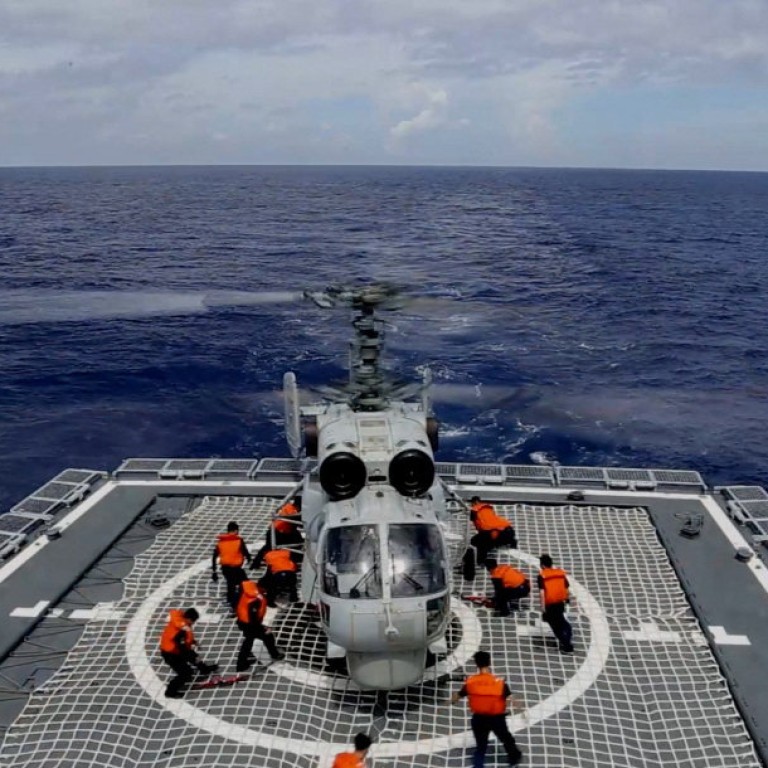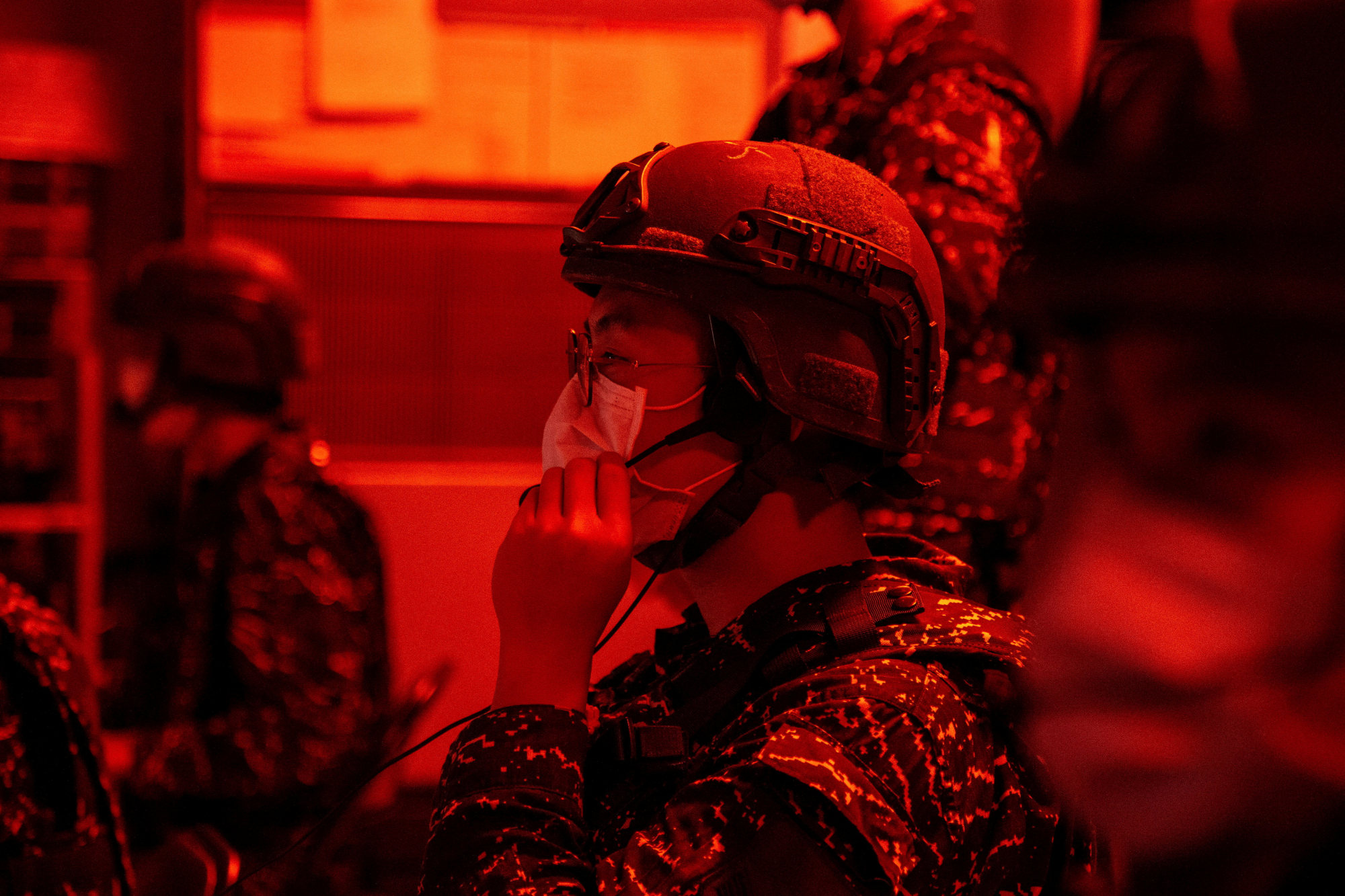
Chinese PLA drills simulating Taiwan blockade seen to become new ‘normal’
- PLA Eastern Theatre Command says joint navy and air force drills will continue, to prepare for ‘defence’ and ‘blockade’ operations
- Beijing ‘determined to link the East and South China seas through the Taiwan Strait’, Taiwanese foreign minister declares
The scale of future People’s Liberation Army drills, however, will depend on actions taken by Taipei and Washington, they believe.
This comes as the PLA’s Eastern Theatre Command said joint navy and air force drills would continue around Taiwan, in preparation for operations of “joint defence” and “joint blockade”.
As of 5pm on Tuesday, the Taiwanese defence ministry had detected a total of 10 PLA fighter jets and 45 aircraft taking part in the drills. As many as 16 had crossed the median line in the Taiwan Strait, a de facto boundary between the self-governed island and mainland China that both sides have largely honoured over the decades.
Beijing’s Maritime Safety Administration also issued navigation warnings, restricting entry into waters east of Nanshan island in the South China Sea from 8am to 6pm until Thursday, as well as the southern waters of the Yellow Sea from 9am to 4pm between Thursday and Saturday.
The PLA manoeuvres started with four days of large-scale live-fire drills last Thursday, shortly after US House Speaker Nancy Pelosi left Taiwan following an unannounced trip which Beijing had repeatedly warned against.
Huge PLA drills around Taiwan seen as warning to US and allies
On Tuesday, Taiwan’s military launched its own live-fire artillery drills in the southern county of Pingtung. The hour-long exercise simulating defence of the island, the first of two planned this week, started with the firing of target flares.
Meeting reporters the same day, Taiwanese Foreign Minister Joseph Wu said Beijing was “determined to link the East and South China seas through the Taiwan Strait so the entire area becomes its internal waters”, with motivations “far beyond Taiwan”.
Beijing has condemned the Taiwanese drills, but Taipei’s defence ministry said they were part of scheduled exercises planned before the latest rise in cross-strait tensions.
By not specifying an end date for the PLA drills, initially expected to wind down on Sunday afternoon, Beijing is benefiting from its own version of “strategic ambiguity”, analysts said, in a reference to the stated US policy on Taiwan under its one-China policy.

“The PLA’s live-fire drills encircling Taiwan have turned the current crisis to China’s advantage,” said Koh King Kee, president of Malaysian think tank Centre for New Inclusive Asia. The practice will eventually become an “accepted reality” for the international community, Koh forecast.
Escalating or reducing the scale of the exercises is up to Beijing, he said, as the US has lost its “position to determine the course of the cross-strait crisis solely on its own terms”.
“Beijing can turn such military exercises into real action any time it deems necessary … or just maintain its current military pressure on Taiwan,” Koh said. Immediate conflict is unlikely, but Beijing will “normalise” regular military drills around Taiwan, as maintaining pressure on the island gives it more control and flexibility, he believes.
“Pelosi’s reckless visit to Taiwan has provided a strategic opportunity [for Beijing] to test-run reunifying Taiwan through forceful means,” he said, adding it had “inadvertently accelerated” the cross-strait reunification process.
Chinese warships and jets skirt Taiwanese coastline in bid to keep up pressure
Asked if the exercises around Taiwan would be normalised, foreign ministry spokesman Wang Wenbin emphasised that they were “open, transparent and professional”, in line with domestic and international laws, and with relevant departments issuing announcements in a timely manner.
Despite growing cross-strait tensions, US President Joe Biden said he was “not worried” about the PLA increasing pressure.
“I’m concerned that they are moving as much as they are,” Biden said. “But I don’t think they are going to do anything more.”
The White House will send more aircraft and warships through the Taiwan Strait and has deployed the USS Ronald Reagan carrier strike group to remain in the region to “monitor the situation”.
US warships will continue to transit the Taiwan Strait and perform freedom of navigation operations in the Indo-Pacific despite the PLA’s live-fire drills, asserted Colin Kahl, US undersecretary of defence for policy.
“It’s a manufactured crisis, but that doesn’t mean we have to play into that,” said Kahl. “What we’ll do instead, is to continue to fly, to sail and to operate wherever international law allows us to do so, and that includes in the Taiwan Strait, and we will continue to stand by our allies and partners in the region.”
The US Senate is due to vote on the Taiwan Policy Act of 2022, a new bill that threatens severe sanctions against Beijing for any aggression against Taipei, and is likely to further anger Chinese authorities if passed.
However, Washington has postponed a long-planned test of an Air Force Minuteman III intercontinental ballistic missile, a move seen as a bid to avoid escalating tensions with Beijing.
The extent of Taiwanese and US actions in the region will determine the scale of the Chinese military’s response, retired PLA colonel Yue Gang said.
What defence dialogues did Beijing cancel after Pelosi’s Taiwan trip?
“Washington and Taipei will not stop their provocation of the mainland, so the PLA will not stop its weighty countermeasures,” Yue said.
Beijing will also be watching Japan, where Prime Minister Fumio Kishida is adopting his predecessor Shinzo Abe’s staunch pro-Taiwan stance, he added.
“To prevent Japan from interfering militarily in the Taiwan issue, Beijing must deter the most threatening Japanese submarine fleet … The PLA’s joint anti-submarine drills [on Monday] were aimed at the Japanese submarines.”
The ongoing drills signify Beijing’s rejection of the concept of Taiwanese waters and airspace, as well as the median line in the Taiwan Strait, which Beijing has never officially accepted, Yue said, adding that the risk of conflict had increased with the erasure of the “virtual boundary”.
“The Taiwan Strait has become a quasi-war zone, which will affect surrounding regions in East Asia and the South China Sea, with continued military crises and intensified volatility of regional security” amid “reshuffled” geopolitical relations.
On Monday, the PLA began a separate set of live-fire drills in the Bohai and Yellow seas, declaring the area off-limits for weeks. The area is close to US military bases in Japan that could provide critical support to Taiwan in the event of conflict with the Chinese mainland.
Military drills have become a “new reality” in the Taiwan Strait, according to Hu Xijin, commentator and former editor-in-chief of nationalist tabloid Global Times.
“The military drills are more like the beginning of the PLA’s normalisation of new elements in their actions in the Taiwan Strait,” Hu wrote on Weibo, China’s Twitter-like platform. “Sealing off the island has become a reality that can be staged at any time.”
The ongoing PLA drills follow distinct objectives each day, including precision tests for missile strikes, simulation of an attack on Taiwan, and the latest – testing a joint blockade by the navy and air force.
However, Yue believes drills of this format will not be frequently repeated. “More economical and cost-effective modes will be implemented to undermine the Taiwanese military’s resolve to deter combat with force through salami-slicing tactics.”
Additional reporting by Jack Lau



